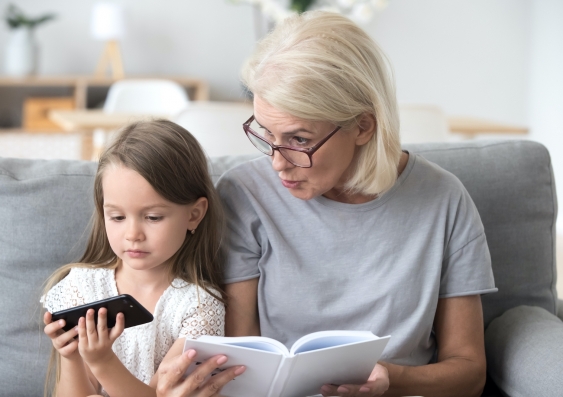New research reveals the diversity of family life in Australia and the need for more inclusive policies to support them.
Nearly one-third of children in Australia are growing up in households that challenge conventional notions of family structures, according to a new report.
The published today is a collaboration between UNSW SydneyāsĢżSocial Policy Research Centre and . It seeks to examine the reality of family life in Australia, especially the families in which children and young people are being raised.
The report analyses the latest Household, Income and Labour Dynamics in Australia (HILDA) and Census data to provide insights into the diversity of families in Australia and how their experiences differ according to their family type. It found while 69 per cent of Australian children live in couple-parent families, more than 30 per cent live in single-parent families, step and/or blended families, multigenerational, and foster and/or other kin families.
āThis important research has uncovered a richness to the diversity of family types in Australia,ā says Dr Yuvisthi Naidoo, lead author of the report from the Social Policy Research Centre at UNSW Arts, Design & Architecture. āThe findings highlight the need for more inclusive support systems that recognise the multifaceted needs of different family structures.ā
Most laws and practices assume that families are couple-parent families. All other family types are treated as anomalies ā if they are recognised at all.
āThe image of the nuclear family ā mother, father and two children ā permeates our cultural understanding of family life,ā says Tracey Burton, CEO of Uniting NSW.ACT. āThis report responds to the need for a more nuanced view, challenging current conventions and celebrating the many different ways people create family when raising children.ā
Media enquiries
For enquiries about this story and interview requests, please contactĀ Ben Knight, News & Content Coordinator, UNSW Arts, Design & Architecture.
±Ź³ó“Ē²Ō±š:Ģż(02) 9065 4915
·”³¾²¹¾±±ō:Ģżb.knight@unsw.edu.au
The report found families that do not fit the couple-parent structure are more likely to have greater caring responsibilities, are more likely to be renting or face insecure housing and experience more financial hardship. Young people who donāt live in couple-parent families are also less likely to be participating in work or study.
āPeople's resources to cope with housing and financial stress, access to education and work, and experiences of disability are affected by who lives in their family,ā Ms Burton says. āAs a frontline service provider to people from across the community, we see firsthand that many families face real-world economic barriers and have been significantly impacted by the cost-of-living crisis.ā
The report has significant public policy implications for governments, that need to better understand and support the diversity of family structures. For example, some welfare programs review household incomes to determine access to support but assume an increase in allowance will help all families to the same extent regardless of size or needs.
āIgnoring different family structures has real-world consequences, and these often fall most heavily on families already struggling with vulnerability or disadvantage,ā Ms Burton said.Ā āThere is still work to do to ensure that the conditions and opportunities are equal for all families, regardless of their makeup.ā
The findings highlight the need for more inclusive support systems that recognise the multifaceted needs of different family structures.
The number of adults in a same-sex relationship within a couple-parent family increased from 11 per cent in 2011 to 17 per cent in 2021.
āThe increase in same-sex families raising children, influenced by shifts in societal attitudes and policy reforms such as the 2017 marriage equality vote, underscores the evolving landscape of family dynamics in Australia,ā Dr Naidoo says. āThis shift highlights the need for inclusive policies that support family formations and ensures equitable access to resources and opportunities.ā
Despite the challenges that many families face, the report also found resilience and care within families of all types. When adults were asked to rate their satisfaction with their relationship with their children and how well the children in a household get along with each other, there was very little difference amongst all family types.
āWe hope this report inspires more discussion about the diverse strengths of all families and better policies and practices that address entrenched disadvantages,ā says , co-lead author of the report from the Social Policy Research Centre.
Uniting Families Report key findings:
- Australian families come in many forms: 69 per cent of children live in couple-parent families, 11 per cent live in sole-parent families, 12 per cent live in step and/or blended families, 6 per cent live in multigenerational families, and around 1 per cent live in foster families or families made up of other kin.
- Family diversity doesnāt fit neatly into categories ā almost 1 in 5 couple-parent families are also step and/or blended families, multigenerational families or foster and other kin families.
- Adults in a same-sex relationship within a couple-parent family increased from 11 per cent in 2011 to 17 per cent in 2021. Same-sex couples belonging to step and/or blended families comprised 3 per cent, while 1 per cent were part of multigenerational families.
- One-third of First Nations families are couple-parent families. First Nations families are more likely to be multigenerational, step and/or blended, sole parents, or foster and other kin families than non-First Nations families.
- Some family types are more likely to be affected by the current rental crisis and lack of affordable housing supply than others. The experience of having insecure housing is more familiar to sole parent and step and/or blended families.
- Multigenerational families have the highest use of informal care for children before they start school (70 per cent), while step and/or blended families have the lowest (35 per cent). Childcare subsidies benefit couple families and single mothers most but can make things more complex for other family types (such as step-blended families).
- Parental support and financial situation influence young peopleās engagement in education and employment. Young people growing up in foster care have the lowest rate of participation of any family type.
- Family types that are most likely to be providing care for people with long-term health conditions and disability are, on average, more likely to already be struggling to cope financially.









